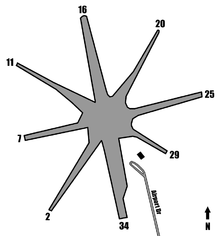West Mesa Airport
| West Mesa Airport | |||||||||||||||||||||||
|---|---|---|---|---|---|---|---|---|---|---|---|---|---|---|---|---|---|---|---|---|---|---|---|
| Summary | |||||||||||||||||||||||
| Airport type | Public | ||||||||||||||||||||||
| Operator | Transcontinental & Western Air | ||||||||||||||||||||||
| Location | Albuquerque | ||||||||||||||||||||||
| Elevation AMSL | 5,101 ft / 1,555 m | ||||||||||||||||||||||
| Coordinates | 35°5′13″N 106°42′56″W / 35.08694°N 106.71556°WCoordinates: 35°5′13″N 106°42′56″W / 35.08694°N 106.71556°W | ||||||||||||||||||||||
| Runways | |||||||||||||||||||||||
| |||||||||||||||||||||||

West Mesa Airport was an airport on Albuquerque, New Mexico's West Side. Built in 1929, it was the city's second airport after the original Albuquerque Airport (completed in 1928). West Mesa was built by Western Air Express and was originally known as "Western Air Express Airport." TWA and Continental Airlines operated out of this airport until the Albuquerque Municipal Airport (now Albuquerque International Sunport) was built in 1939. Cutter-Carr Flying Service (known later as Cutter Flying Service or Cutter Aviation) operated flight instruction and fuel service until shortly before West Mesa Airport closed in 1967.
The airport had four unpaved runways arranged in a star shape. The longest was 16/34 at 6300 feet, followed by 7/25 (5700 feet), 2/20 (5400 feet), and 11/29 (4550 feet).
When built, the airport stood alone on the West Mesa, surrounded by acres of empty desert. Today, the site is bounded by Coors, Unser, Central, and I-40 and has been mostly covered up by new development, though several of the old runways and the foundation to the hanger are still at least partially visible. The largest and most obvious remnant of West Mesa is the quarter-mile stretch of Runway 11 on the north side of Los Volcanes Road, but traces of Runways 7 and 16 can also be identified as of 2017.